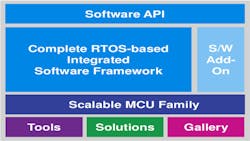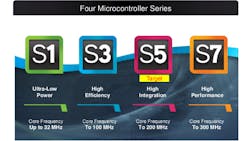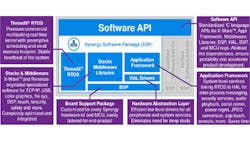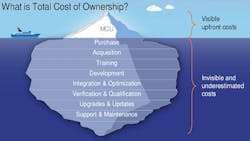Synergistic Tools Highlight New Microcontroller Family
In 2003, Hitachi and Mitsubishi Electric formed Renesas Electronics, which merged with NEC Electronics six years later in 2009. Such actions required supporting a wide range of hardware, including software that eventually could handle a wide range of disparate architectures with a major embedded base. Its e2 studio, an Eclipse-based IDE, supports Renesas' for RL78, RX, RH850, RZ/A1, SH-2, and SH-2A.
The company’s latest hardware and software environment is called the Renesas Synergy Platform for IoT (Fig. 1). The hardware is built around microcontrollers that have ARM Cortex-M cores. The initial crop includes the S1, S3, S5 and S7 with 32-bit cores like the Cortex-M3 (Fig. 2).
The Renesas Synergy Software Package (SSP) is a modular system comprising qualified tools, libraries, and an operating system to allow developers to quickly build their application (Fig. 3). It includes a version of the ThreadX RTOS from Express Logic that has been customized to take advantage of the underlying hardware. SSP includes support for Express Logic's middleware, stacks and, runtime, including X-Ware and GUI-X. The combination allows remote boot and over-the-air (OTA) updates necessary to maintain applications targeting the Internet of Things (IoT) that seems to cover most consumer and industrial applications these days.
The IDE, based on Eclipse, features support for the SSP software API, including ThreadX RTOS integration. Among the tools in the software suite is pin-reconfiguration capability, which enables developers to generate the configuration for a target chip so that signals will connect to the desired pin.
Tight integration of the IDE with the Express Logic tools allows for some interesting features. In particular, developers get a royalty-free, run-time license for the support software (e.g., ThreadX) rather than just receiving the binary. This tends to make debugging more difficult, since tracing into the RTOS results in a display with machine code. With SSP, developers will see the ThreadX source code, and are able to step through it like they would with their application or if they had purchased the source code. Tracing and breakpoints also work in this way as well.
The source code isn’t in a form that’s used to rebuild the operating system. It can be purchased from Express Logic, which some projects may require to meet some certifications.
The compiler tools support standards like MISRA C:2012. Though this can be important to developers, it’s often more useful if the third-party tools also follow these standards, especially for applications that require safety and security certifications. No doubt, it’s a key reason why Renesas chose Express Logic as a partner.
Another part of the puzzle is the Renesas Synergy Gallery, which is essentially an “app store” for SSP. Of course, the store doesn’t usually maintain apps, but rather Renesas and third-party tools, middeware, and libraries that work with SSP. The gallery is a bit exclusive since the components are certified to work together.
As per usual, the cost of the microcontrollers covers the chip as well as the software that comes with it. This can usher in a significant savings because Renesas addresses more than just the hardware and an IDE (Fig. 4).
Renesas' Synergy provides a single source for tech support, leading to reduced total cost of ownership (TCO). It’s based on standard tools such as Eclipse and ThreadX.
Synergy represents a significant change for Renesas. The hardware and software are built from the ground up, and the chips are designed to challenge the horde of ARM Cortex-M microcontrollers on the market. Most come with free IDEs and some even come with an RTOS at no additional cost, but few provide the depth of support found in Synergy.
About the Author
William G. Wong
Senior Content Director - Electronic Design and Microwaves & RF
I am Editor of Electronic Design focusing on embedded, software, and systems. As Senior Content Director, I also manage Microwaves & RF and I work with a great team of editors to provide engineers, programmers, developers and technical managers with interesting and useful articles and videos on a regular basis. Check out our free newsletters to see the latest content.
You can send press releases for new products for possible coverage on the website. I am also interested in receiving contributed articles for publishing on our website. Use our template and send to me along with a signed release form.
Check out my blog, AltEmbedded on Electronic Design, as well as his latest articles on this site that are listed below.
You can visit my social media via these links:
- AltEmbedded on Electronic Design
- Bill Wong on Facebook
- @AltEmbedded on Twitter
- Bill Wong on LinkedIn
I earned a Bachelor of Electrical Engineering at the Georgia Institute of Technology and a Masters in Computer Science from Rutgers University. I still do a bit of programming using everything from C and C++ to Rust and Ada/SPARK. I do a bit of PHP programming for Drupal websites. I have posted a few Drupal modules.
I still get a hand on software and electronic hardware. Some of this can be found on our Kit Close-Up video series. You can also see me on many of our TechXchange Talk videos. I am interested in a range of projects from robotics to artificial intelligence.




